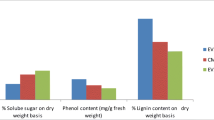Abstract
Maydis leaf blight (MLB) caused by Cochliobolus heterostrophus is one of the most important fungal diseases of maize. A study was conducted for phenotypical characterization of ten Indian maize inbred lines, which were grouped based on phenotyping and their morpho-physiological attributes against MLB disease. On the basis of phenotyping, they were categorized into five resistant inbreds viz., SC-7-2-1-2-6-1, SC24 (92)-2-3-2-1-1, DMSC-16-2, V-351-1-4 and HKI MBR-139-2, and five susceptible inbreds viz., CM-119, DMSC-28, HKI PC-8, HKI 1040-C2 and V341. The leaf hair density was high in resistant genotypes (249.79/microscopic field, at 100×) and significantly less in susceptible genotypes (99.33/microscopic field at 100×). Stomata count was found less (6.12/microscopic field, at 400×) in resistant genotypes as compared to susceptible genotypes (10.56/microscopic field at 400×). The rate of photosynthesis was high in uninoculated control plant than in the inoculated plants. Under inoculated conditions photosynthetic rate was significantly high in resistant lines than the susceptible inbred lines which were gradually reduced with the advancement of time. The transpiration rate of inoculated plants was also higher than the control plants at 5 days after inoculation (DAI), whereas it was decreased in both inoculated and control plants at 40 DAI. Elevated level of transpiration was detected in susceptible genotypes under inoculated condition. Upon inoculation stomatal conductance was decreased with the passage of time. However, there was a differential behavior in the stomatal conductance recorded in the tested maize inbred lines under control conditions.



Similar content being viewed by others
References
Ahuja SC, Payak MM (1978) A field inoculation technique for evaluating maize germplasm to banded leaf and sheath blight. Indian Phytopathol 31:517–520
Anonymous (2011a) Production, supply and distribution (PSD) database. http://www.fas.usda.gov/psdonline. Accessed May 2018
Anonymous (2011b) Agricultural statistics at a glance 2010. Directorate of economics and statistics. Department of agriculture and cooperation, ministry of agriculture, GOI. http://www.agricoop.com. Accessed May 2018
Bashyal BM, Chand R, Kushwaha C, Joshi AK, Kumar S (2011) Bipolaris sorokiniana of barley: infection behavior in different members of Poaceae. Indian Phytopathol 64:28–31
Chattopadhyaya S, Ali KA, Doss SG, Das NK, Aggarwal RK, Bandopadhyay TK, Sarkar A, Bajpai AK (2011) Association of leaf micro-morphological characters with powdery mildew resistance in field-grown mulberry (Morus spp.) germplasm. AoB Plants. https://doi.org/10.1093/aobpla/plr002
Duniway JM, Durbin RD (1971) Some effects of Uromyces phaseoli on the transpiration rate and stomatal response of bean leaves. Phytopathology 61:114–119
Hooda KS, Chikkappa GK, Kumar B, Rajendran A, Kumar P, Jat SL (2011b) DMR Vision 2030. Directorate of Maize Research, Pusa, New Delhi, p 24
Khederkar SA (2009) Investigations on the variability and management of turcicum leaf blight in maize caused by Exserohilum turcicum (Pass.) Leonard and Suggs. M.Sc (Agri) Thesis UAS, Dharwad, India
McGrath MT, Pennypacker SP (1990) Alteration in physiological processes in wheat flag leaves caused by stem rust and leaf rust. Phytopathology 80:677–686
Nair SK, Prasanna BM, Garg A, Rathore RS, Setty TAS, Singh NN (2005) Identification and validation of QTLs conferring resistance to sorghum downy mildew (Peronosclerospora sorghi) and Rajasthan downy mildew (Peronosclerospora heteropogoni) in maize. Int J Plant Breed Res 110(8):1384–1392
Payak MM, Sharma RC (1980) An inventory and bibliography of maize diseases in India. Division of Mycology and Plant Pathology, IARI, New Delhi, India, 44 pp
Payak MM, Sharma RC (1983) Disease rating scales in maize in India. In: Techniques of scoring for resistance to diseases of maize in India. All India Co-ordinated Maize Improvement Project, IARI, New Delhi, pp 1–4
Reed HS, Cooley JS (1913) The effect of the cedar rot upon the assimilation of carbon dioxide by apple leaves. Rep Va Agric Exp Stn 91–94
Sharma RC, Rai SN (2000) Assessment and quantitative analysis of losses due to Dreschlera maydis in maize. In: Proceedings of international conference integrated plant disease management sustainable agriculture indian phytopathology, pp 246–248
Sharma RC, Rai SN (2005) Evaluation of maize inbred lines for resistance to maydis leaf blight. Indian Phytopathol 58:339–340
Yen TTO, Prasanna BM, Setty TAS, Rathore RS (2004) Genetic variability for resistance to sorghum downy mildew (Peronosclerospora sorghi) and Rajasthan downy mildew (P. heteropogoni) in the tropical/sub-tropical Asian maize germplasm. Euphytica 138:23–31
Acknowledgements
Authors are thankful to Head, Division of Plant Pathology, ICAR-Indian Agricultural Research Institute (Grant no. PGS/3-11/2010/5026), New Delhi-110 012, India for providing guidance and facilities for carrying out this work smoothly.
Author information
Authors and Affiliations
Corresponding author
Rights and permissions
About this article
Cite this article
Manjunatha, C., Gogoi, R., Singh, B. et al. Phenotypic and physiological characterization of maize inbred lines resistant and susceptible to maydis leaf blight. Indian Phytopathology 72, 217–224 (2019). https://doi.org/10.1007/s42360-019-00117-w
Received:
Revised:
Accepted:
Published:
Issue Date:
DOI: https://doi.org/10.1007/s42360-019-00117-w




